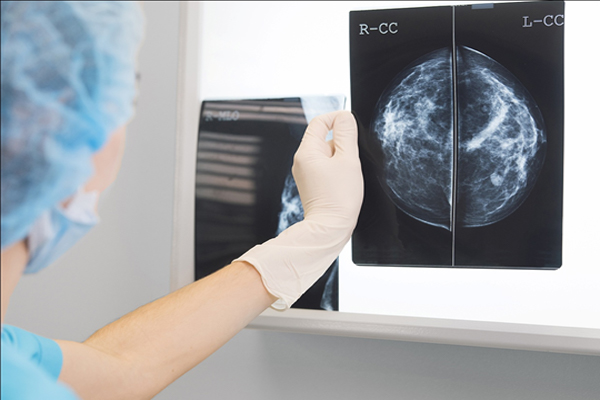

Breast cancer is the leading cause of deaths in women in industrialized countries and its incidence continues to escalate. Therefore early detection to improve breast cancer outcomes remains the cornerstone of breast cancer control.
Non-invasive diagnosis of the breast masses with imaging modalities remains one of the major concerns.
Sonography is the primary workup tool in young women. It is considered a sensitive modality for the detection of breast cancers, which is one of the varieties of factors leading to false-negative findings on mammography.
INTRODUCTION
1. Breast is made up of glandular, fatty, and fibrous tissues. There is a layer of fatty tissue that surrounds the breast glands and runs throughout the entire breast giving the breast its soft consistency.
2. Solid breast lesions may be benign or malignant. Fibroadenoma is the common benign breast lesion, while invasive ductal carcinoma is the most common malignancy
3. B-mode sonography is an indispensable complementary examination for the investigation of breast masses, whether they are palpable or not.
4. One of the new techniques of ultrasound is sonoelastography.
ELASTOGRAPHY AND ITS PRINCIPLE
1. Elastography is a non-invasive medical imaging technique that detects tumors based on their stiffness (elasticity).
2. The technique of ultrasound elastography is based on the principle that the soft parts of tissue deform more easily than harder parts of tissue under compression, thus allowing an objective determination of tissue consistency
3. Generally, breast cancer tissue is harder than the adjacent normal breast tissue. This property serves as the basis for some examinations, such as palpation, that are currently being used in the clinical assessment of breast abnormalities, as well as for elastography. It is the difference in tissue stiffness which contributes in the differentiation between benign and malignant lesions
4. Differences in the echo reflection from selected lesion tissue and background tissue during compressed and non-compressed intervals are quantified and then used to produce an elastogram.
5. Areas of high strain, indicating easily compressed tissue such as adipose tissue, generate a red pixel on the ultrasound-viewing screen.
6. Areas of high strain, demonstrated by tissues that tend to compress to the same degree as fibroglandular or benign tissue, generate green pixels, while areas of a lower strain, indicating hard or malignant tissue, generate blue pixels.
7. A color map is then generated and is superimposed over the gray-scale ultrasound images. A grading scale used to categorize lesions based on the color signature generated by the evaluation of target lesions.
Colour elastogram of a lesion, Blue – Hard, Red - Soft
The grading scale used to categorize lesions based on the color signature in elastogram
Sonoelastography of breast lesions:
1) 25 years female with multiple bilateral palpable breast lump
a. The conventional US showed well-defined iso to hypoechoic focal lesion
b. On elastography: the score was 2(the lesion showed a heterogeneous but mostly green color signature) Surgical excision was done and diagnosis was confirmed to be fibroadenoma.
2) 24 years female with a palpable right breast lump.
a. The conventional US showed well defined simple cyst. (b) On elastography BGR pattern (blue, green and red pattern). Confirmed by follow up after 6 months to be a simple cyst.
b. It is, therefore, be used to differentiate cystic lesions from solid fine echoic lesions as seen on atypical cyst.
3) 55 years female with a palpable left breast lump.
(a) Conventional US Hypoechoic lesion with irregular borders with detected vascularity on color Doppler
(b) Elastography of the lesion showed score 4
(c) FNAC of the mass revealed infiltrating ductal carcinoma
4) Forty-five-year-old woman with ductal carcinoma in situ.
a. B-mode US image (A) shows microlobulated intracystic mass. Sonoelastographic image (B) shows almost entire solid component as blue, indicating hard lesion with elasticity score of 4.
b. B-mode showed low suspicion for malignancy, but subsequent sonoelastography reclassified it as moderate suspicion for malignancy).
c. US-guided vacuum-assisted biopsy and subsequent surgical excision revealed papillary ductal carcinoma in situ
APPLICATIONS ELATOGRAPHY IN BREAST
1. Characterization of Benign/Malignant solid lesions.
a. Can improve the specificity of the BIRADS score.
b. Reclassify BIRADS 3 & 4a lesions.
c. Useful for malignant lesions presenting as benign on B-mode.
2. Can improve the specificity of the BIRADS score.
3. Characterization of micro-calcification clusters.
4. Elastography of lymph nodes.
5. Monitoring treatment response to neoadjuvant chemotherapy in Ca Breast patients.
OTHER APPLICATIONS OF ELASTOGRAPHY
• Prostate Imaging
• Thyroid Imaging
• Liver Imaging
• IntravasculaStrain Imaging
• Cardiac Elastography
• DeepVeinThrombosis
• KidneyTransplant MonitoringGE Voluson E8 at KIMSHEALTH Kottayam
CONCLUSION
Real-time elastography has shown the potential to provide additional characterization of breast lesions and to improve the specificity for low suspicion lesions achieved at the conventional US.
Note: The information in this article is based on various case-based studies conducted around the world and webinar information from various radiologists. The purpose is to circulate the information to the maximum possible.
Dr. Rakshith, MBBS, MD
Radiologist
